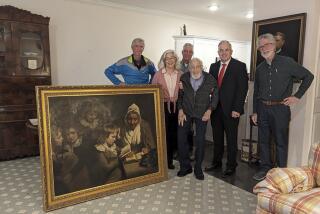‘Like finding lost Rembrandts’
Peter Mullin cracks open the door of a 1935 Voisin Type C25 Aerodyne at the back of the auto museum bearing his name. He points out the intricate details of a vibrant Art Deco interior, restored to its original luster.
A small ashtray hangs on the inside of each door — made from etched Lalique crystal.
Light streams into the car through three small glass windows in the fully retractable roof. A bold black and white patterned fabric covers the doors, seats and roof, sourced from the same French textile mill that wove the original fabric more than seven decades ago.
“You can see why this one is kind of the favorite,” Mullin says of the C25 with a smile.
Once relegated to the scrap heap of automotive history, the Voisin brand has undergone a renaissance within the classic car world. The cars, which cost as much as a Bugatti in the 1920s and 30s, are worth millions of dollars today. They were the creation of Gabriel Voisin, a colorful yet fastidious French architect and engineer who made a fortune selling airplanes during World War I.
Mullin’s navy blue and grey C25 won Best of Show at the 2011 Pebble Beach Concours d’Elegance, arguably the most prestigious prize in the classic car world. Another Voisin, a 1934 C15 ETS Saliot-bodied Roadster, won Best of Show in 2002.
When Pebble Beach Concours hosted Voisin as the featured marque in 2006, it provoked a frenzied reaction among collectors.
“It was like finding the lost Rembrandts,” said Richard Adatto, an expert in classic French cars and a member of the classic car show’s selection committee.
Prior to 2006, he said, no Voisin had sold for more than $1 million. After that, prices nearly doubled. Peter Mullin’s C25 could be worth as much as $5 million today, said David Gooding, president and founder of the Gooding & Co. auction company. Most experts estimate there are 250 to 300 known Voisin automobiles, though they are starting to turn up as barn finds throughout Europe.
Fortunately for Mullin, he got into the brand early.
“I fell in love with the Art Deco nature of Voisin a number of years ago,” Mullin said. “One by one, they found their way into the collection.”
In addition to his prize-winner, Mullin owns 15 other exceptionally rare and valuable Voisin models on display at the Mullin Automotive Museum in Oxnard until the end of April. The museum is also home to dozens of gleaming prewar cars from other French marques like Bugatti, Delahaye and the odd Talbot-Lago.
Mullin, the man, owns nearly everything in the building. But the Voisin cars have become his favorite, not just for their intricate details, but because they embody the values of the man behind their nameplate.
Gabriel Voisin was a colorful figure who made a name for himself in the early 1900s as an aviation pioneer. Despite being in their mid-20s, Voisin and his younger brother Charles started the world’s first aircraft company. Their early planes set several European flight records.
Gabriel Voisin kept the company open after his brother was killed in a 1912 car crash, and sold several thousand fighter planes to the French military and its allies for use in World War I.
After the war ended, a glut of planes and little demand for new ones pushed Voisin to build a machine with a more benevolent purpose. He spent roughly the next 20 years building some of the most elaborate and expensive cars of the era. The rigors of aviation engineering and attention to detail carried into Voisin’s forward-thinking automobiles.
“Everything was designed all the way out,” Adatto said. “Even the taillights were handmade.”
Many of Voisin’s cars have struts connecting the front wheel fender to the grille — like the wing struts common on aircraft from the era. The cars were largely built from lightweight materials such as aluminum or magnesium. Most cars from that time — and even today — were built from heavier steel.
Inside, the dashboard of many Voisin vehicles had gauges to show oil pressure and temperature in an era when most cars didn’t even have a fuel gauge, Adatto said. A complex engine design used sleeve valves rather than the standard overhead poppet valves found on engines today.
Though not as powerful as cars with inline eight-cylinder engines, sleeve valve engines like the one in Mullin’s C25 were known for their quiet, if somewhat smoky, operation. “There’s an old saying that if your Voisin doesn’t smoke, then there’s something wrong with it,” Mullin said with a chuckle.
Mullin said his 1935 C25 sold new for 88,000 francs, roughly the same price as a Bugatti roadster of the day. Yet a Voisin had infinitely more panache, said Jonathan Stein, an automotive historian and classic car judge.
“They were like spaceships,” Stein said. “There was nothing in the contemporary design idiom to prepare people for Voisin.”
Voisin buyers included the upper crust of French society, including actors Maurice Chevalier and Rudolph Valentino, architect Le Corbusier and writer H.G. Wells.
The global economic crisis of the 1930s spelled doom for a company relying on only a small subset of wealthy buyers.
“By 1934 the market was off; people just couldn’t afford this stuff,” Adatto said. “But, man, did it look good.”
After losing control of his company in 1932 and then returning in 1933, Voisin was forced to permanently shut his operation in 1937, Adatto said.
Voisin made a pass at the other end of the automotive spectrum shortly after World War II, designing a microcar called the Biscooter. This inexpensive and lightweight two-passenger car went on to sell more than 12,000 units in Spain, according to Mullin. One of the early prototypes is also on display in his museum.
Despite his contributions to the automotive landscape and his successful aircraft company, Voisin always felt slighted for his contributions to flight being overshadowed by the Wright brothers. “He took it pretty hard,” Mullin said. “It frustrated him forever.”
So it is with some irony that a resurgence of interest in Voisin’s machines has been with his cars rather than his planes.
“His aircraft were great in their time, and they contributed a significant amount to the early period of flight,” said Peter Jakab, associate director of the Smithsonian National Air and Space Museum.
Nevertheless, clear evidence suggests the Wright brothers were indeed building and flying superior planes earlier than the Voisin brothers, Jakab said.
Voisin largely retired from the professional world by 1960, spending his remaining 13 years surrounded by women and writing his memoirs. His declining years were spent living with two women in a house by a river, according to Adatto.
“He was a real man about town,” Adatto said. “He was as passionate about his women as he was his airplanes, cars and motorcycles.”
david.undercoffler@latimes.com







